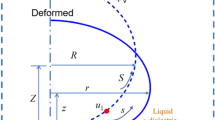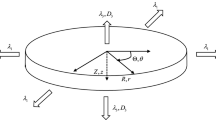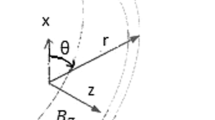Abstract
Solenoids, ubiquitous in electrical engineering applications, are devices formed from a coil of wire that use electric current to produce a magnetic field. In contrast to typical electrical engineering applications that pertain to their magnetic field, of interest here is their use as actuators by studying their mechanical deformation. An analytically tractable model of parallel, coaxial circular rings is used to find the solenoid’s axial deformation when subjected to a combined electrical (current) and mechanical (axial force) loading. Both finite and infinite solenoids are considered and their equilibrium configurations as well as their stability are investigated as functions of their geometry and applied current intensity.




Similar content being viewed by others
Notes
It should be noted here that a coil with parallel rings can also be realized experimentally (see [7]).
Due to the small pitch angle of the solenoid coils considered here, even for relatively large relative displacements \(e_{i}\) between turns \((e_{i} \equiv \lambda _{i} - 1)\) — in Sect. 2.2 we consider up to \(|e_{i}|= |e| =0.5\) — the force-displacement relation for the coil is assumed to remain linear. Large strain nonlinear effects are taken into account in the hyperelastic encasing tube which provides a stiffening response with increasing \(e\).
The tube is assumed incompressible neo-Hookean and in a uniaxial stress state; different constitutive laws could easily be considered.
For simplicity the naked coil ring spacing is given but the uniform strain solution \(e\) in the presence of an encasing hyperelastic tube is a straightforward solution of (2.6).
An externally applied reaction force \(f_{ext} = f \) is needed for maintaining the applied strain \(e\).
As expected from translational invariance, an eigenvalue \(\beta =0\) always exists and corresponds to \(\omega =0\) (see also (2.11)).
Standard MKSA system of units is used in this subsection.
In Sect. 3.2 a coil of diameter \(2a = 10^{-1}\) m is considered with a wire of thickness \(\rho = 10^{-3}\) m.
References
Abramowitz, M., Stegun, I.: Handbook of Mathematical Functions. Dover, New York (1965)
Gourdin, W.H.: Analysis and assessment of electromagnetic ring expansion at a high-strain-rate test. J. Appl. Phys. 65, 411–422 (1989)
Griffiths, D.: Introduction to Electrodynamics. Pearson Education, Upper Saddle River (2014)
Jackson, J.D.: Classical Electrodynamics, 3rd edn. Wiley, New York (1999)
Kovetz, A.: Electromagnetic Theory. Oxford University Press, London (2000)
Love, A.E.H.: A Theasise on the Mathematical Theory of Elasticity. Dover, New York (1944)
Mainy, A.: Dynamic buckling of thin metallic rings under external pressure. Master’s thesis, University of Texas (2012)
Thomas, J., Triantafyllidis, N.: On electromagnetic forming processes in finitely strained solids: theory and examples. J. Mech. Phys. Solids 57(8), 1391–1416 (2009)
Thomas, J.D., Seth, M., Bradley, J., Daehn, G., Triantafyllidis, N.: Forming limits for electromagnetically expanded aluminum alloy tubes: theory and experiment forming limits for electromagnetically expanded aluminum alloy tubes: theory and experiment. Acta Mater. 55, 2863–2873 (2007)
Triantafyllidis, N., Waldenmyer, J.: Onset of necking in electro-magnetically formed rings. J. Mech. Phys. Solids 52, 2127–2148 (2004)
Zhang, H., Ravi-Chandar, K.: On the dynamics of necking and fragmentation – I. Real-time and post-mortem observations in Al 6061-O. Int. J. Fract. 142, 183–217 (2006)
Zhang, H., Ravi-Chandar, K.: On the dynamics of necking and fragmentation – IV. Expansion of Al 6061-O tubes. Int. J. Fract. 163, 41–65 (2010)
Acknowledgements
This work is dedicated to a good friend and an excellent scholar, Prof. Roger Fosdick on the occasion of his 85th birthday.
Author information
Authors and Affiliations
Contributions
Ryan Elliott and Nicolas Triantafyllidis have both contributed in the concept of the work, calculations and writing of the manuscript.
Corresponding author
Ethics declarations
Competing interests
The authors declare no competing interests.
Additional information
Publisher’s Note
Springer Nature remains neutral with regard to jurisdictional claims in published maps and institutional affiliations.
Appendices
Appendix A: Naked and Tube-Encased Coil Stiffnesses
The stiffness of the naked solenoid depends on its geometry. For the helicoidal coil the stiffness \(k_{s}\) is given by (3.2). For the parallel ring naked solenoid, the stiffness of the separating ligament is
Assuming a minimum encasing tube thickness of \(h=2\rho \), we conclude from the definitions in (3.1) of the dimensionless tube stiffness parameter \(S\) and the aspect ratio \(R\) that
For soft polymeric tubes and metallic solenoids (typically copper) the ratio is of the order \(G_{t}/G_{s} \approx 10^{-3}\) while a typical valueFootnote 9 of the ratio \(\rho /2a \approx 10^{-2}\), thus justifying the range of values for \(S\) used in the calculations of Sect. 3.
Appendix B: Electric Current Limitations
Finally, an interesting question can be raised on the subject of any physically imposed limits to the magnitude of the applied currents. Two physical mechanisms are here at play: the dielectric resistance of the medium in which the solenoid is encased and the ohmic heating of the solenoid wire. We bypass the first issue under the hypothesis of good electrical isolating properties of the encasing tube and address here the limitations due to the second mechanism.
Assuming a complete conversion of ohmic losses to heat in a circular section of radius \(\rho \) wire of conductivity \(\gamma \), mass density \(m\) and specific heat \(c_{p}\) we have that the maximum current \(I_{\text{max}}\) allowed by an increase of temperature rate \(\dot{\theta}_{\text{max}}\)
For a coil made of copper wire (in MKSA units: \(m = 8.94 \times 10^{3},\; \gamma = 5.96 \times 10^{7},\; c_{p}= 0.385 \times 10^{3}\)) of radius \(\rho = 10^{-3}\) (the dimensions considered in Sect. 3.2) we have the following maximum current
Consequently assuming \(\dot{\theta}_{\text{max}} = 1^{\circ}/\)sec the maximum current can be \(I_{\text{max}} \approx 45\) A while for \(\dot{\theta}_{\text{max}} = (10^{-2})^{\circ}/\)sec the corresponding \(I_{\text{max}} \approx 4.5\) A, thus giving an estimate of how fast the three different solenoids of Sect. 3.2 are heating.
Rights and permissions
Springer Nature or its licensor (e.g. a society or other partner) holds exclusive rights to this article under a publishing agreement with the author(s) or other rightsholder(s); author self-archiving of the accepted manuscript version of this article is solely governed by the terms of such publishing agreement and applicable law.
About this article
Cite this article
Elliott, R.S., Triantafyllidis, N. Mechanical Response of Metal Solenoids Subjected to Electric Currents. J Elast 154, 407–419 (2023). https://doi.org/10.1007/s10659-023-10015-y
Received:
Accepted:
Published:
Issue Date:
DOI: https://doi.org/10.1007/s10659-023-10015-y




